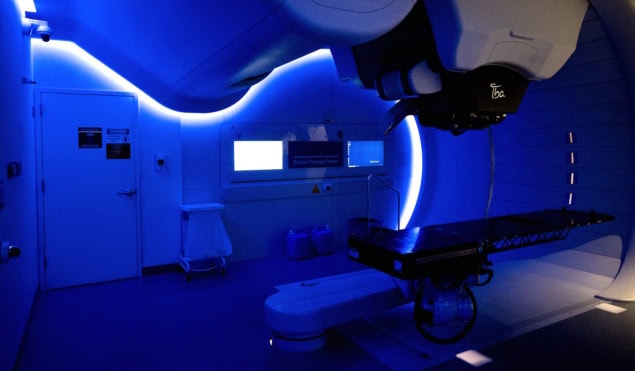
Head-and-neck cancers are difficult to treat with radiation therapy because they are often located close to organs that are vital for patients to maintain a high quality-of-life. Radiation therapy can also alter a person’s shape, through weight loss or swelling, making it essential to monitor such changes throughout the treatment to ensure effective tumour targeting.
Researchers from Corewell Health William Beaumont University Hospital have now used a new proton therapy technique called step-and-shoot proton arc therapy (a spot-scanning proton arc method) to treat head-and-neck cancer in a human patient – the first person in the US to receive this highly accurate treatment.
“We envisioned that this technology could significantly improve the quality of treatment plans for patients and the treatment efficiency compared with the current state-of-the-art technique of intensity-modulated proton therapy (IMPT),” states senior author Xuanfeng Ding.
Progression towards dynamic proton arc therapy
“The first paper on spot-scanning proton arc therapy was published in 2016 and the first prototype for it was built in 2018,” says Ding. However, step-and-shoot proton arc therapy is an interim solution towards a more advanced technique known as dynamic proton arc therapy – which delivered its first pre-clinical treatment in 2024. Dynamic proton arc therapy is still undergoing development and regulatory approval clearance, so researchers have chosen to use step-and-shoot proton arc therapy clinically in the meantime.
Other proton therapies are more manual in nature and require a lot of monitoring, but the step-and-shoot technology delivers radiation directly to a tumour in a more continuous and automated fashion, with less lag time between radiation dosages. “Step-and-shoot proton arc therapy uses more beam angles per plan compared to the current clinical practice using IMPT and optimizes the spot and energy layers sparsity level,” explains Ding.
The extra beam angles provide a greater degree-of-freedom to optimize the treatment plan and provide a better dose conformity, robustness and linear energy transfer (LET, the energy deposited by ionizing radiation) through a more automated approach. During treatment delivery, the gantry rotates to each beam angle and stops to deliver the treatment irradiation.
In the dynamic proton arc technique that is also being developed, the gantry rotates continuously while irradiating the proton spot or switching energy layer. The step-and-shoot proton arc therapy therefore acts as an interim stage that is allowing more clinical data to be acquired to help dynamic proton arc therapy become clinically approved. The pinpointing ability of these proton therapies enables tumours to be targeted more precisely without damaging surrounding healthy tissue and organs.
The first clinical treatment
The team trialled the new technique on a patient with adenoid cystic carcinoma in her salivary gland – a rare and highly invasive cancer that’s difficult to treat as it targets the nerves in the body. This tendency to target nerves also means that fighting such tumours typically causes a lot of side effects. Using the new step-and-shoot proton arc therapy, however, the patient experienced minimal side effects and no radiation toxicity to other areas of her body (including the brain) after 33 treatments. Since finishing her treatment in August 2024, she continues to be cancer-free.

“Radiation to the head-and-neck typically results in dryness of the mouth, pain and difficulty swallowing, abnormal taste, fatigue and difficulty with concentration,” says Rohan Deraniyagala, a Corewell Health radiation oncologist involved with this research. “Our patient had minor skin irritation but did not have any issues with eating or performing at her job during treatment and for the last year since she was diagnosed.”
Describing the therapeutic process, Ding tells Physics World that “we developed an in-house planning optimization algorithm to select spot and energy per beam angle so the treatment irradiation time could be reduced to four minutes. However, because the gantry still needs to stop at each beam angle, the total treatment time is about 16 minutes per fraction.”

World’s first patient treatments delivered with proton arc therapy
On monitoring the progression of the tumour over time and developing treatment plans, Ding confirms that the team “implemented a machine-learning-based synthetic CT platform which allows us to track the daily dosage of radiation using cone-beam computed tomography (CBCT) so that we can schedule an adaptive treatment plan for the patient.”
On the back of this research, Ding says that the next step is to help further develop the dynamic proton arc technique – known as DynamicARC – in collaboration with industry partner IBA.
The research was published in the International Journal of Particle Therapy.



